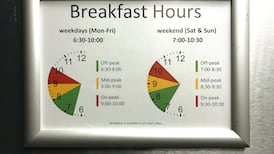The last year has been a challenging one all over the world for all of us. The death and devastation caused by Covid-19 is unrivalled in our generation. Those who have been very sick, those who have died, those who have lost loved ones, those who have lost their livelihoods, those who have been lonely and isolated.
It has also been a time of tremendous scientific advancement. It was about this time last year that we knew good progress had been made in developing a vaccine and we will soon be at the anniversary of the first shipment into Ireland, which came on St Stephen’s Day.
The available Covid-19 vaccines are the product of decades of industry investment in research and development – intellectual property is the backbone that enables companies to invest in scientific innovation. In 2020, Pfizer spent more than $9 billion on research and development, and we expect to surpass $10 billion in 2021.
Hospital Report
In 2020 we invested more than $2 billion at-risk to scale up manufacturing of our vaccine while it was under development, and we did not avail of any public or government money in the development of the vaccine.
There was no manufacturing at scale of any mRNA vaccine or medicine anywhere in the world prior to this. We created this manufacturing infrastructure from scratch.
To meet global demand, we have continued to build our global manufacturing network – we are working with 20 facilities in eight countries across four continents and our Grange Castle site received $40 million investment this year to produce drug substance for the vaccine.
The patent system has enabled us to build this infrastructure and to quickly mobilise and devote the resources, technical knowledge and know-how that is required. Maintaining that system which recognises intellectual property is what will fuel the next generation of scientific innovation.
The patent system helps to ensure that we are not susceptible to ‘bad actors’ who might take advantage of the gap in patents to prevent us from manufacturing our own treatments and vaccines. And at the same time, it provides a mechanism for us to collaborate to address the pandemic.
Low-income countries
Due to significant investment and scaling up of infrastructure, we remain on track to produce three billion doses this year, of which at least a billion will go to middle- and low-income countries at a not-for-profit price, and we expect to manufacture four billion doses in 2022, of which a billion doses will go to low-income countries.
Pfizer-BioNTech has supplied vaccines to territories and countries in every region of the world – more than 871 million doses to 97 low- and middle-income countries, including 91.5 million doses to 37 countries on the African continent.
We are doing this in a number of ways. We have 64 direct supply agreements in place with governments around the world, 40 of which are for low- and middle-income countries. We are a partner to Covax with a supply agreement to provide 40 million doses in 2021.
And we collaborate with governments wishing to share or donate doses – to date we have worked with country governments, Covax, the US government and the European Commission, to facilitate donation of more than 155 million doses to 79 countries all over the world.
Vaccine infrastructure has not been a bottleneck for us manufacturing more quickly. A challenge has been the scarcity of highly specialised raw materials needed to produce our vaccine. These 280 different components are produced by many suppliers in 19 different countries. Many of them needed our substantial support (technical and financial) to ramp up their production.
According to EFPIA figures, it’s currently estimated that there are 12.6 billion vaccine doses already produced by the industry, and 16.2 billion doses will be available by next February. Partnership across the biopharmaceutical industry has been crucial to this Herculean effort – across all the companies making Covid vaccines, there has been 329 collaborations with third parties to increase production.
At the same time, countries have faced major challenges in the pandemic – not least in getting more people vaccinated. That challenge isn’t simply about supply. It’s also about healthcare infrastructure, logistics and vaccine confidence.
For some countries with significant population, Pfizer has officially been asked by their governments over the past several months to delay or pause shipments due to; ability to absorb due to excess supply of vaccine (across all manufacturers) in the country; lower uptake rates due to hesitancy; limited healthcare capacity/infrastructure/syringe supply or other capacity issues such as workforce constraints and, in many cases, a combination of the above.
Arduous task
Improving vaccination rates around the world is an arduous task requiring improvements in healthcare delivery on the ground and building vaccine confidence among the public.
We are partnering with Covax, to analyse supply chain capabilities in low-income countries to understand where we can lend expertise and support the delivery of any Covid-19 vaccine, including dry ice supply and transportation.
We’re working with the UPS Foundation, which is donating freezers to countries that need assistance with building out their ultra-cold chain capacity.
And we’ve ‘taken to the skies’ – as part of a four-year partnership with Zipline, we are supporting a pilot initiative in Ghana, focused on delivering vaccines to hard-to-reach areas using drones.
Managing Covid-19 and increasing vaccination around the world is a massive but achievable undertaking and we are firmly committed to equitable and affordable access for Covid-19 vaccines.
However, singling out vaccine production is a distraction from the real challenges and solutions needed to improve global vaccination levels.
So too are the calls for a Trips (trade-related aspects of intellectual property rights) waiver. Vaccine production is at unprecedented levels, a Trips waiver will not solve the key challenges in increasing global vaccination.
Karen O’Keeffe is director of policy and public affairs at Pfizer Ireland









